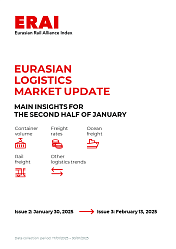First, it’s essential to look at two points of China’s new Covid-19 prevention and control protocols closely related to China-Europe rail traffic. To begin with, according to governmental decisions, «from January 8, 2023, Covid-19 is classified as a ‘Class B infectious disease’. No isolation is required anymore for people infected with the virus [...], while there will be no requirement for quarantining when entering the country».
The absence of quarantine concerns both people and goods. It will facilitate the transport of products destined for China since waiting times to ensure that cargo is safe to enter the country will be eliminated. Both Europe and China look at the development with optimism since it could signal a new peak season following winter production and respective eastbound exports in 2023.
Additionally, the second point concerns the optimisation of people flows between China and foreign countries: «Personnel travelling to China should undergo a Covid-19 test 48 hours before their departure. Those with a negative result can travel to China without applying for a health code from an embassy or consulate abroad. Testing and centralised isolation of all staff after entry will stop,» mention the revised rules.
In total, there are three ways that China-Europe rail freight could benefit from the relaxed rules. As analysed below, the new approach could positively impact eastbound volumes, Eurasian multimodal transport and the re-emerging possibility of business trips.
Entry quarantine The goods most affected by entry epidemic prevention measures are fresh food. In June 2020, imported salmon caused a resurgence of the domestic epidemic and directly affected cold chain transportation in Europe: since seafood products are generally stored and transported in refrigerators, the virus has a chance to survive in the cold for a long time. After this incident, the import of salmon has encountered many obstacles, and the customs have become extremely cautious. Coincidentally, in January 2022, the Manzhouli Port announced that the import of fruit was prohibited, and the reason was that the imported fruit tested positive for Covid-19.
Imported fruits entering the Chinese market through border inspection also face cumbersome procedures. In addition to the conventional customs declaration, inspection and quarantine certificates, disinfection certificates, and fruit nucleic acid test certificates are also required. Therefore, the new policy implemented in 2023 will reduce the complicated procedures of fresh food imports, reduce customs clearance time, and create more prospects for the market of fresh food imports. The China-Laos ‘fruit train’ previously reported by China Railway Transport and the China-Russia special fresh produce train launched by Russian Railways in April this year will also go straight to the fast lane.
Multimodal transport
On top of the limitation of goods’ imports, restrictions on personnel during multimodal transport operations also prolonged the overall transit times between China-Europe. As an essential part of multimodal transportation, truck drivers have encountered slow customs clearance procedures and even travel bans due to strict epidemic prevention and control. The approaching relaxed Covid-19 rules in China could result in better conditions for truck drivers. Moreover, they could boost domestic multimodal routes, such as the direct truck connection between Hong Kong and Shenzhen, which will also assist in achieving faster and more efficient cargo forwarding to China-Europe freight trains.
Business trips
For many rail transport peers, the pandemic in the past three years has made the China-Europe freight train market, which already faced information-sharing obstacles, even more difficult. No amount of online conversations can be as smooth as a few greetings in person. 2023, which will see Chine gradually reopening to the world, is also a good time for the counterparts of the China-Europe rail to go out, restructure Eurasian railway transportation, and have a dialogue and exchange between freight forwarders and cargo owners.
RailFreight.com presents the first opportunities through 2023 for the industry to come together and pick up the Eurasian transport thread where they had left it three years ago when the pandemic started. On 19 and 20 April 2023, the RailFreight Summit will take place in Warsaw, Poland. Since it will also tackle Silk Road-related topics, it is the perfect occasion to re-introduce the industry and pave the way for more interaction and shared-interest business solutions.





